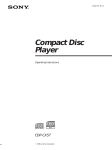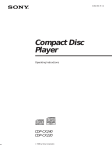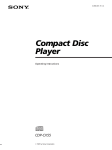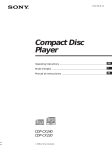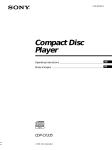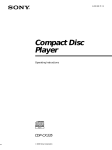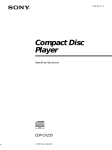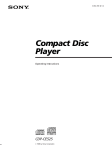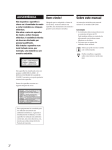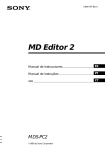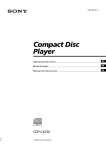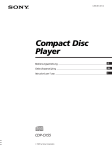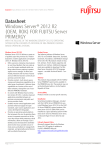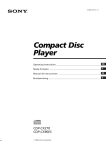Download Sony Ericsson CDP-CX270 User's Manual
Transcript
3-856-767-21 (1)
Operating Instructions
f
CDP-CX270
CDP-CX90ES
1996 by Sony Corporation
WARNING
To prevent fire or shock
hazard, do not expose
the unit to rain or
moisture.
To avoid electrical shock,
do not open the cabinet.
Refer servicing to
qualified personnel only.
This symbol is intended to alert
the user to the presence of
uninsulated “dangerous voltage”
within the product’s enclosure
that may be of sufficient
magnitude to constitute a risk of
electric shock to persons.
This symbol is intended to alert
the user to the presence of
important operating and
maintenance (servicing)
instructions in the literature
accompanying the appliance.
INFORMATION
This equipment has been tested and
found to comply with the limits for a
Class B digital device, pursuant to Part
15 of the FCC Rules. These limits are
designed to provide reasonable
protection against harmful interference
in a residential installation. This
equipment generates, uses, and can
radiate radio frequency energy and, if
not installed and used in accordance
with the instructions, may cause harmful
interference to radio communications.
However, there is no guarantee that
interference will not occur in a particular
installation. If this equipment does cause
harmful interference to radio or
television reception, which can be
determined by turning the equipment off
and on, the user is encouraged to try to
correct the interference by one or more of
the following measures:
2
– Reorient or relocate the receiving
antenna.
– Increase the separation between the
equipment and receiver.
– Connect the equipment into an outlet
on a circuit different from that to
which the receiver is connected.
– Consult the dealer or an experienced
radio/TV technician for help.
CAUTION
Welcome!
Thank you for purchasing the Sony
Compact Disc Player. Before operating
the unit, please read this manual
thoroughly and retain it for future
reference.
You are cautioned that any changes or
modification not expressly approved in
this manual could void your authority to
operate this equipment.
About This Manual
Owner’s Record
Conventions
The model and serial numbers are
located at the rear of the unit.
Record the serial number in the space
provided below. Refer to them whenever
you call upon your Sony dealer
regarding this product.
• Instructions in this manual describe
the controls on the player.
You can also use the controls on the
remote if they have the same or similar
names as those on the player.
• The following icons are used in this
manual:
Model No. _________________________
Serial No. _________________________
This equipment is intended for home
entertainment purposes only. The
warranty shall be invalidated if used
in commercial environments, such as
by disc jockeys, etc., even within the
Warranty Period.
The instructions in this manual are for
models CDP-CX270 and CDP-CX90ES.
Indicates that you can do the
task using the remote.
Indicates hints and tips for
making the task easier.
TABLE OF CONTENTS
Getting Started
Unpacking ............................................................................................................................
Hooking Up the System .....................................................................................................
Controlling Another CD Player (Player Control) ..........................................................
Inserting CDs .......................................................................................................................
Playing a CD .........................................................................................................................
4
4
6
8
10
Playing CDs
Using the Front Panel Display .......................................................................................
Using the On-Screen Display .........................................................................................
Locating a Specific Disc ..................................................................................................
Sorting Out Discs in Three Ways (Sort) ........................................................................
Specifying the Next Disc to Play ...................................................................................
Locating a Specific Track or a Point in a Track ............................................................
Playing Repeatedly ...........................................................................................................
Playing in Random Order (Shuffle Play) ......................................................................
Creating Your Own Program (Program Play) ..............................................................
Playing Alternately (G-Fade Play) .................................................................................
Playing Using a Timer......................................................................................................
Using a Sony Receiver With the On-Screen Display Control Function ....................
12
13
13
14
16
16
17
18
18
21
22
22
Storing Information About CDs (Custom Files)
What You Can Do With the Custom Files ....................................................................
Labeling Discs (Disc Memo)............................................................................................
Grouping Discs (Group File) ...........................................................................................
Storing Custom File Information Using a Keyboard ...................................................
Storing Specific Tracks (Delete File) ...............................................................................
Storing Your Favorite Tracks (Hit List) .........................................................................
23
23
26
28
28
29
Additional Information
Precautions ........................................................................................................................
Notes on CDs .....................................................................................................................
Troubleshooting ................................................................................................................
Specifications .....................................................................................................................
30
30
31
31
Index ........................................................................................................................... Back cover
3
Getting Started
Unpacking
Check that you received the following items:
• Audio cord (1)
• Video cord (1)
• Remote commander (remote) (1)
• Sony SUM-3 (NS) batteries (2)
• CD booklet holders (2) and label (1)
How to use the CD booklet holder
Hooking Up the System
Overview
This section describes how to hook up the CD player to
a TV and an amplifier. Be sure to turn off the power of
each component before making the connections.
When connecting to an amplifier with a video input jack
The CD booklet holder helps you locate the discs easily.
After you have inserted discs into the player, you can put
the CD booklet (which comes with a CD) into the
supplied holder. Put two CD booklets facing back to back
into a pocket. Stick the number label on each pocket,
matching the number of the disc slot where you have
inserted the disc. You can put up to 200 CD booklets into
the holders.
Inserting batteries into the remote
You can control the player using the supplied remote.
Insert two R6 (size AA) batteries by matching the +
and – on the batteries. When using the remote, point it
at the remote sensor g on the player.
CD player
To an AC outlet
To LINE OUT
To MONITOR OUT
To TV
To audio input
To video input
Amplifier
When to replace batteries
With normal use, the batteries should last for about six
months. When the remote no longer operates the player,
replace all the batteries with new ones.
Notes
• Do not leave the remote near an extremely hot or humid
place.
• Do not drop any foreign object into the remote casing,
particularly when replacing the batteries.
• Do not expose the remote sensor to direct sunlight or
lighting apparatuses. Doing so may cause a malfunction.
• If you do not use the remote for an extended period of time,
remove the batteries to avoid possible damage from battery
leakage and corrosion.
4
: Signal flow
To an AC outlet
Getting
Playing
Started
CDs
When connecting to an amplifier without a video input
jack
When connecting to an amplifier with a video input jack
CD player
CD player
LINE
IN
VIDEO
VIDEO IN
L
L
R
R
AUDIO IN
When connecting to an amplifier without a video input
jack
To an AC outlet
To LINE OUT
MONITOR OUT
OUT
Amplifier
To MONITOR OUT
CD player
LINE
IN
To video input
TV
MONITOR OUT
TV
INPUT
OUT
L
L
R
R
VIDEO
L
AUDIO
R
Amplifier
To audio input
CD
To an AC outlet
Amplifier
L
R
• If you have a Sony receiver (amplifier) equipped with
the CONTROL A1 jack
: Signal flow
To an AC outlet
What cords will I need?
Audio cord (1) (supplied)
White
(L)
Red
(R)
White
(L)
Red
(R)
Be sure to connect the player to the VIDEO 2 jacks on the
receiver (amplifier). When making this connection, leave
the COMMAND MODE of the player to CD2 which is set at
the factory.
If you further connect the player and the receiver
(amplifier) via the CONTROL A1 jacks with the CONTROL
A1 cord (not supplied), you can use the Automatic Function
Selection feature between these components. For details,
refer to the supplementary “CONTROL-A1 Control
System” instructions and the instructions supplied with the
receiver (amplifier).
Video cord (1) (supplied)
Yellow
Yellow
• If you have a Sony receiver (amplifier) with the
On-Screen Display Control function
You can control the player using the on-screen display and
the remote supplied with the receiver.
For details, see page 22.
Hookups
When connecting the cords, be sure to match the colorcoded plugs to the appropriate jacks on the
components: Yellow (video) to Yellow, Red (right) to
Red and White (left) to White. Be sure to make
connections firmly to avoid hum and noise.
5
Getting Started
• If you have a digital component such as a digital
amplifier, D/A converter, DAT or MD
Connect the component via the DIGITAL OUT (OPTICAL)
connector using an optical cable (not supplied). Take off the
cap and plug in the optical cable.
POC-15
Optical cable (not supplied)
CD player
Digital component
DIGITAL OUT
DIGITAL INPUT
OPTICAL
OPTICAL
Controlling Another CD Player
(Player Control)
If you have a Sony CD player equipped with the
CONTROL A1 jack, you can control that player as the
second player with this unit. After connecting the
second player, you can select either player by simply
pressing the PLAYER SELECT button and enjoy
playing the discs inserted in both players. Be sure to
turn off the power of each player before making this
connection.
To LINE IN
To LINE OUT
Note
CDP-CX270/CX90ES
When you connect via the DIGITAL OUT (OPTICAL)
connector, noise may occur when you play CD software
other than music, such as a CD-ROM.
When using another Sony CD player together with
this player
You can make the supplied remote effective only for this
player.
• When using a player equipped with the COMMAND
MODE selector:
Leave the COMMAND MODE selector of this player
to CD2 which is set at the factory and that of another
player to CD1 or CD3. Then set the CD1/2/3 switch on
the remote supplied for each player accordingly.
• When using a player not equipped with the
COMMAND MODE selector:
The command mode of the player without the
COMMAND MODE selector is set to CD1. Leave the
COMMAND MODE selector of this player and the
CD1/2/3 switch on the remote to CD2.
To CONTROL A1
To an AC outlet
To CONTROL A1
To AC OUTLET
To CONTROL A1
CDP-CX200 etc.
Connecting the AC power cord
Connect the AC power cord to a wall outlet.
Note on placement
To audio output
To audio input
Be sure to place the player on a horizontal surface.
If the player is slanted, it may cause a malfunction or
damage the player.
Amplifier
: Signal flow
6
To an AC outlet
Getting
Playing
Started
CDs
4
What cords will I need?
• Audio cord (1) (supplied with the player to be connected)
• CONTROL A1 cord (1) (not supplied)
1
Connect the players with the audio cord (see also
“Hookups” on page 5).
CDP-CX200 etc.
CDP-CX270/CX90ES
LINE
IN
2
LINE OUT
Connect the AC power cord of the second player
to AC OUTLET on the rear of this player.
When you turn on both players and this player detects
the second player, “REMOTE” appears in the second
player‘s display.
You cannot operate the second player using the
controls on the second player while “REMOTE”
appears in the second player’s display.
OUT
L
L
L
R
R
R
Connect the players with the CONTROL A1 cord.
CONTROL A1
REMOTE
CD3
While the second player is selected, “2nd PLAYER”
appears in this player‘s front panel display.
CONTROL A1
Note
Do not connect a player other than a Sony CD player
equipped with the CONTROL A1 jacks to the LINE IN jacks
of this player. If you do, a loud noise may occur and damage
the speakers.
For details on this connection, refer to the
supplementary “CONTROL-A1 Control System”
instructions.
3
Set the COMMAND MODE selector of each
player.
Leave the COMMAND MODE of this player set to
CD2, and set that of the second player to CD3
You can connect the CD player CDP-CX153 as the
second player
Connect the CONTROL A1 jack of this player and the
CONTROL A jack of the CDP-CX153. For details, refer to
the supplementary “CONTROL-A1 Control System”
instructions.
Note that you cannot use the G-Fade Play function (see
page 21) when connecting the CDP-CX153.
COMMAND MODE
CD
1
2
3
7
Getting Started
3
Inserting CDs
You can insert up to 200 discs into this player.
POWER
Front cover
OPEN
Turn the JOG dial until you find the disc slot
where you want to insert a disc, while checking the
disc number (written beside every five slots and
also indicated in the display).
JOG
Disc number
Disc slot at the loading position
The disc number at the loading position appears in
the front panel display.* If you have labeled the
disc with disc title (see page 23), the disc title
appears instead of the disc number. As you turn
the JOG dial, the disc number or the disc title
changes.
Playing position
Rotary table
Loading position
Disc number
ALL DISC S
1
Press POWER to turn on the player.
2
Press OPEN.
DISC
CD2
*DISC-93*
New Artist
93
ART.
Disc number or disc title
* If you have already inserted discs, the disc number at
the playing position appears. When you turn the JOG
dial, the displayed disc number changes to the one at
the loading position.
Front
cover
4
Insert a disc with the label side facing right.
Notes
• Make sure you have inserted the disc into each slot at
a right angle to the rotary table. If the disc is not put
in straight, it may damage the player or the disc.
• Make sure the rotary table comes to a complete stop
before inserting or removing discs.
With the label side
facing right
8
Getting
Playing
Started
CDs
After inserting the disc, you can replace the disc
number with the original disc title (see “Labeling
Discs” on page 23) to locate it easily when you
start playing.
ALL DISC S
CD2
SONYHITS
Sony Band
DISC
93
ART.
5
Repeat Steps 3 and 4 to insert more discs.
6
Close the front cover by pushing up the cover until
it clicks.
Removing CDs
After following Steps 1 through 3 of “Inserting CDs”
on page 8, remove the discs. Then close the front cover.
Note
The disc being played does not come to the loading position if
you open the front cover during playback. (The disc number
flashes in the display.)
If you want to remove the disc being played, press ENTER in
the center of the JOG dial after opening the front cover. The
disc comes to the loading position. Remove the disc after the
rotary table comes to a complete stop.
The rotary table turns and the disc slot at the
loading position is set to the playing position.
Always keep the front cover closed except when
you insert or remove discs.
The supplied CD booklet holders help you locate a
disc
You can store up to 200 CD booklets. Insert a booklet and
stick the number label on the film of a pocket and the
booklet so that you can locate the disc easily.
Notes
• When you insert an 8 cm (3-inch) CD, be sure to attach a
Sony CSA-8 adaptor (not supplied) to the disc.
Do not insert an empty 8 cm (3-inch) CD adaptor (CSA-8). It
may damage the player.
• Do not attach anything such as seals or sleeves to discs. It may
damage the player or the disc.
• If you drop a disc into the player and the disc won‘t go into
the slot correctly, consult your nearest Sony dealer.
• When transporting the player, remove all discs from the
player.
9
Basic Operations
Playing a CD
2 3
4
5
ENTER
DISC/CHARACTER
PLAYER
SELECT
ENTER
INPUT
SORT
CONTINUE SHUFFLE PROGRAM
REPEAT
TIME/TEXT
GROUP 1
GROUP 2
GROUP 3
GROUP 4
HIT LIST
GROUP 5
GROUP 6
GROUP 7
GROUP 8
X-FADE
AMS
POWER
CHECK
CLEAR
TIMER
OFF
PLAY
• See pages 4–6 for hookup
information.
• Make sure you have inserted the
discs correctly as indicated on
page 8.
• You can play all tracks on a disc
or on all discs in the original
order (Continuous Play). When
connected to the second player,
you can play the discs in this
player and the ones in the
second player consecutively (see
page 6).
1
2
3
You can turn on the player
by pressing the POWER
switch on the remote Z
4
OPEN
Turn on the amplifier and select the CD player position.
Press POWER to turn on the player.
Press CONTINUE to select ALL DISCS or 1␣ DISC Continuous
Play mode.
Each time you press CONTINUE, “ALL DISCS” or “1␣ DISC”
appears in the front panel display.
When you select
The player plays
ALL DISCS
All discs in the player consecutively according to the
selected sorting method (see “Sorting Out Discs in
Three Ways” on page 14). Empty disc slots are
skipped.
1 DISC
Only one disc you have selected
Turn the JOG dial until the disc number or the disc title (see
“Labeling Discs” on page 23) you want appears in the front
panel display to select the first disc (ALL DISCS) or the disc
you want (1␣ DISC).
ALL DISC S
CD2
*DISC-93*
New Artist
ART.
10
DISC
93
Basic Operations
5
When you turn off the player
The player remembers the
last playing disc and the
play mode [Continuous,
Shuffle (see page 18) or
Program (see page 18)].
When you turn on the
player again, therefore, the
player is ready to play the
same disc in the same play
mode.
Press ENTER to start playing.
The selected disc is set to the playing position, and the player
plays all the discs from the selected one (ALL DISCS) or all the
tracks once (1␣ DISC).
Adjust the volume on the amplifier.
To stop playback
Press p.
≠/±
OPEN
ENTER
DISC/CHARACTER
PLAYER
SELECT
ENTER
INPUT
SORT
CONTINUE SHUFFLE PROGRAM
REPEAT
TIME/TEXT
GROUP 1
GROUP 2
GROUP 3
GROUP 4
HIT LIST
GROUP 5
GROUP 6
GROUP 7
GROUP 8
X-FADE
AMS
POWER
CHECK
CLEAR
TIMER
OFF
PLAY
OPEN
P
Basic Operations
·
p
To
Press
Pause
P
Resume playing after pause
P or ·
Go to the next disc
DISC SKIP + once.
Hold down the button to skip discs.
Go back to the preceding disc
DISC SKIP – once.
Hold down the button to skip discs.
Go to the next track
±
Go back to the preceding track
≠
Stop playing and remove the disc
OPEN and then ENTER. The disc comes
to the loading position.
11
Playing CDs
Using the Front Panel Display
You can check information about the disc using the
front panel display.
Front panel display
Display information while playing a disc
Each time you press the TIME/TEXT button, the front
panel display shows the current disc information as
shown below.
Disc title
TIME/TEXT
ALL DISC S
NEXT DISC
1O2
CD-TEXT
CD2
Disc number/
Track number/
Playing time
SONYHITS
93 1
1.52
DISC
TRACK
MIN
SEC
Press TIME/TEXT.
ALL DISC S
NEXT DISC
1O2
CD-TEXT
CD2
Disc title
SONYHITS
HitechBlues
TRACK
Track title
This information also appears
when the player locates the
track.
Press TIME/TEXT.
If you have not labeled the track (see “Labeling each
track” on page 24), the front panel display information
does not change when you press the TIME/TEXT
button.
TIME/TEXT
EXTRA
If you have CD-TEXT discs
Display information before you start
playing
The front panel display shows the current disc title and
artist name. If you have not labeled the disc, the disc
number and “New Artist” appear instead of the Disc
Memo information (see “Labeling Discs” on page 23).
When you press the TIME/TEXT button, you can
check the total number of tracks and total playing time
of the disc.
Disc title
ALL DISC S
DISC
93
CD-TEXT
CD2
SONYHITS
Sony Band
ART.
Artist name
Press TIME/TEXT.
ALL DISC S
DISC
93
CD-TEXT
CD2
Disc title
SONYHITS
93 1O 6O.28
DISC
Disc number
12
TRACK
MIN
SEC
Total number Total playing time
of tracks
CD-TEXT discs have information, such as the disc titles
or artist names, memorized in a blank space on the
discs where there is no information on normal discs.
The CD-TEXT information (disc title, artist name and
track title) will be stored as the Disc Memo
automatically, so you can check that information in the
same way as shown above.
To play disc highlights Z
Some CD-TEXT discs have a feature to play only the
highlights of the discs.
Press EXTRA in the stop mode. The player starts playing the
disc highlights in Continuous Play mode. The indicator on
the · button flashes while playing disc highlights.
If you press the EXTRA button while selecting a disc without
this feature, “NO HIGHLIGHT” appears in the front panel
display.
• You can cancel playing disc highlights by pressing the ·
or 0/) buttons on the remote.
• You can play the previous or next highlight on the disc by
pressing the ≠/± buttons (AMS, see page 16).
• You can repeat disc highlights (see page 17).
Press REPEAT. The player repeats all the highlights on the
disc. During Repeat 1 mode, the player repeats only the
current highlight.
Getting
Playing
Started
CDs
You can adjust the on-screen display position on the
TV screen
Using the On-Screen Display
If you connect the player to your TV as indicated on
pages 4 and 5, you can control the player while
checking information with the on-screen display on the
TV screen.
After connecting the player and TV, select the video
input on the TV. If you have a Sony TV, you can select
the video input by pressing the TV/VIDEO button on
the supplied remote.
While the front cover is open, press TIME/TEXT then
press Â/µ/M/m on the remote to adjust the position.
Locating a Specific Disc
PLAYER SELECT
ENTER
JOG
Display information while playing a disc
The on-screen display shows the current disc
information stored in the Custom Files (see page 23)
and playing time of the track.
Playing time of the track
Disc title
Track titles
DISC/CAPS
Artist name
PLAYER
SELECT
Number
buttons
Group name
ENTER
Display information while controlling the
player
The on-screen display shows information useful for
each operation.
MEMO SCAN
·
Title bar
Selecting a disc on the player
Selected item
Turn the JOG dial until the disc number or disc title
(see page 23) you want appears in the front panel
display. Press ENTER to start play.
The following icons are used in the on-screen display.
When the on-screen
display shows
It means
Selecting a disc directly using the remote
1 Press DISC/CAPS.
>/./?//
You can select the items using the
Â/µ/M/m buttons on the remote
2
H
The track is stored in the Hit List (see
page 29)
T
The disc is CD-TEXT disc
2
The disc is inserted in the second
player
Press the number button of the disc.
Example: To enter number 35
Press 3, then 5.
To enter number 100
Press 1, then 0 twice.
3
Press ENTER to start play.
13
Playing CDs
Selecting a disc when connected to the
second player
1 Press PLAYER SELECT to select the player in
which the disc you want is inserted.
When you select the second player, “2nd
PLAYER” appears in the front panel display.
2
Sorting Out Discs in Three
Ways (Sort)
When locating discs, you can select three sorting
methods, by disc number, disc title and artist name.
SORT
Select the disc you want following the procedure
in ”Selecting a disc on the player” or “Selecting a
disc directly using the remote.”
ENTER
JOG
Locating a disc by scanning each disc title
(Memo Scan) Z
You can locate a disc you want to play quickly by
scanning the disc titles (see page 23) in the front panel
display and start playing.
Note that you cannot use this function in ALL DISCS
Shuffle Play mode.
1
Press MEMO SCAN.
“MEMO SCAN” appears and the disc titles scroll
in the front panel display.
To cancel Memo Scan
Press MEMO SCAN again.
2
Press · when the disc title of the disc you want
to play appears.
The disc is set to the playing position, and the
player starts playing.
In Program Play mode, the disc will be added to
the end of the program if you press the ENTER
button instead of the · button.
Note
ENTER
SORT
Â/µ/M/m
Each time you press the SORT button, the sorting
method changes as shown below.
n Disc number
If “NO ENTRY” appears in the front panel display, no disc
has been labeled with disc titles. Try the Memo Scan function
again after labeling the discs with disc titles (see page 23).
n Disc title
Press SORT.
Artist name N
Press SORT.
Press SORT.
When you sort by
The display shows the discs in
Disc number
Numerical order of the disc numbers
Disc title*
Alphabetical order of the disc titles
Artist name*
Alphabetical order of the artist names
* Label discs to sort them by disc titles and artist names (see
“Labeling Discs” on page 23).
14
Getting
Playing
Started
CDs
When locating a disc by disc number
1 Press SORT repeatedly to select the sorting
2
method.
Press M/m on the remote repeatedly to select the
first character of the disc title you want.
Front panel display
Front panel display
First character
ALL DISC S
DISC
CD2
SONYHITS
SORT/No.
93
ALL DISC S
CD2
SONYHITS
Sony Band
S
ART.
On-screen display
The on-screen display shows
disc titles from disc number 91.
Each time you press the M/m buttons, you can
select alphabets and then numbers.
The characters which have not been used as the
first character of disc titles will be skipped and the
next one will appear.
Notes
• When searching disc titles, blanks before the first
character in the disc title are ignored.
• When searching disc titles, upper and lower case
characters cannot be differentiated.
The empty disc
slots appear
indented.
2
3
Turn the JOG dial (when using the remote, press
Â/µ repeatedly) to select the disc you want.
When using the remote, you can skip every 10
discs by pressing the M/m buttons.
Press ENTER to start playing the disc.
The disc number being played is highlighted in the
on-screen display.
When locating a disc by disc title
You can search a disc title by specifying the first
character of the disc title. When you specify a
character, the disc titles starting with the character
appear.
3
Turn the JOG dial (when using the remote, press
Â/µ repeatedly) to select the disc you want.
4
Press ENTER to start playing the disc.
When locating a disc by artist name
You can locate a disc by artist name. When you specify
an artist name, the disc titles of the artist appear.
1
Press SORT repeatedly to select the sorting
method.
Front panel display
ALL DISC S
CD2
1
Press SORT repeatedly to select the sorting
method.
DISC
93
SONYHITS
SORT/ARTIST
Front panel display
ALL DISC S
CD2
SONYHITS
SORT/ABC
DISC
S
On-screen display
Selected artist name
On-screen display
First character
Disc titles of the artist
(Continued)
15
Playing CDs
2
Press M/m on the remote repeatedly to select the
artist name.
3
Turn the JOG dial (when using the remote, press
Â/µ repeatedly) to select the disc you want.
4
Press ENTER to start playing the disc.
Locating a Specific Track or a
Point in a Track
You can quickly locate any track while playing a disc
using the ≠/± (AMS: Automatic Music Sensor)
buttons or number buttons on the remote. You can also
locate a specific point in a track while playing a disc.
Specifying the Next Disc to
Play
You can specify the next disc to play while playing a
disc in Continuous or 1 DISC Shuffle Play mode.
While playing a disc, turn the JOG dial until the disc
number or disc title (see page 23) you want appears in
the front panel display.
≠/±
Next disc number
ALL DISC S
CD2
NEXT DISC
NEXT DISC
1O2
*DISC-1O2*
New Artist
TRACK/SPACE
ART.
Next disc number or
disc title appears for a while.
After the current disc is played, the next disc you have
specified starts playing.
If you want to skip to the next disc right away, press
ENTER while playing the current disc.
To cancel the disc you have specified
Press CONTINUE twice.
16
Number
buttons
ENTER
Â/µ
=/+
0/)
Getting
Playing
Started
CDs
To locate
Press
the next or
succeeding tracks
± repeatedly until you find the
track
the current or
preceding tracks
≠ repeatedly until you find the
track
a specific track
directly Z
TRACK/SPACE, the number button
of the track, and then ENTER. When
you locate a track with a number over
10, press the tens digit first, then the
ones digit.
a point in a track
while monitoring the
sound Z
) (forward) or 0 (backward) and
hold down until you find the point
a point in a track
quickly by observing
the display Z
) (forward) or 0 (backward) and
hold down until you find the point
during pause. You will not hear the
sound during the operation.
Note
If “OVER” appears in the front panel display, the disc has
reached the end while you were pressing the ) button.
Press 0 or ≠ to go back.
Checking the track titles using
the on-screen display Z
After labeling tracks (see page 24), you can select the
track you want before you start playing while checking
the track titles.
1
Press TRACK/SPACE.
Track number
Playing Repeatedly
You can play discs/tracks repeatedly in any play
mode.
REPEAT
Press REPEAT while playing a disc.
“REPEAT” appears in the front panel display. The
player repeats the discs/tracks as follows:
When the disc is played in
The player repeats
ALL DISCS Continuous Play
(page 10)
All tracks on all discs
1␣ DISC Continuous Play
(page 10)
All tracks on the current disc
ALL DISCS Shuffle Play
(page 18)
All tracks on all discs in
random order
1␣ DISC Shuffle Play
(page 18)
All tracks on the current disc
in random order
Program Play (page 18)
The same program
Disc number
To cancel Repeat Play
Press REPEAT repeatedly until “REPEAT OFF” appears in the
front panel display.
Repeating the current track (Repeat 1)
You can repeat only the current track.
The track titles stored in Delete File appear
indented (see ”Storing Specific Tracks” on page
28).
2
Press Â/µ to select the track you want.
3
Press ENTER to start playing the track.
The track number being played is highlighted in
the on-screen display.
While the track you want is being played, press
REPEAT repeatedly until “REPEAT 1” appears in the
front panel display.
17
Playing CDs
You can go to the next disc during 1␣ DISC Shuffle Play
Playing in Random Order
(Shuffle Play)
Press DISC SKIP +.
You can have the player “shuffle” the tracks and play
in random order. The player shuffles all the tracks on
all discs or on the disc you specified.
SHUFFLE
·
ENTER
JOG
You can specify the next disc to play during 1␣ DISC
Shuffle Play
Turn the JOG dial to specify the next disc. After all the
tracks on the current disc are played in random order,
the next disc starts playing. If you want to skip to the
next disc right away, press ENTER while playing the
current disc.
Notes
1
Press SHUFFLE to select ALL DISCS or 1 DISC
Shuffle Play mode.
Each time you press SHUFFLE, “ALL DISCS” or
“1 DISC” appears in the front panel display.
When you select
The player plays
ALL DISCS
All tracks on all discs in
random order. When
connected to the second
player, the player selects the
tracks from both this player
and the second player.
1␣ DISC
2
3
All tracks on the selected disc
in random order
When you want to specify the disc for 1 DISC
Shuffle Play, turn the JOG dial until the disc
number or disc title (see page 23) you want
appears in the front panel display.
Press ENTER or ·.
ALL DISCS or 1␣ DISC Shuffle Play starts.
“
” appears in the front panel display while the
player is “shuffling” the discs or the tracks.
• You cannot specify the next disc to play during ALL DISCS
Shuffle Play.
• Even if you press the p button or turn off the player during
ALL DISCS Shuffle Play, the player remembers which
discs/tracks were played and which were not. Therefore, if
you want to start ALL DISCS Shuffle Play again from the
beginning, be sure to repeat the procedure from Step 1.
Creating Your Own Program
(Program Play)
You can arrange the order of the tracks and/or discs to
create three different programs and the programs are
stored automatically. A␣ program can contain up to 32
“steps” — one “step” may contain a track or a whole
disc.
You can also create programs by different procedure
using the remote. You can use both the front panel and
the on-screen display information when programming
in either procedure.
Creating a program on the player
PROGRAM
≠/±
ENTER
JOG
To cancel Shuffle Play
Press CONTINUE.
You can start Shuffle Play while playing
Press SHUFFLE, and Shuffle Play starts from the current
track.
You can directly select a disc for 1 DISC Shuffle Play
See “Selecting a disc directly using the remote” on page 13.
18
·
CHECK
CLEAR
Getting
Playing
Started
CDs
1
2
The programs remain even after Program Play ends
Press PROGRAM until the program number you
want (PROGRAM␣ 1, 2 or 3) appears in the front
panel display.
If a program is already stored in the selected
program number, the last step of the program
appears in the front panel display. When you want
to erase the whole program, hold down CLEAR
until “ALL CLEAR” appears in the front panel
display (see page 20).
When you press the · button, you can play the same
program again.
When you press PROGRAM during Continuous or
Shuffle Play
The program will be played after the current track.
The programs remain until you erase them
If you replace discs, the programmed disc and track
numbers remain. So, the player plays only the existing
disc and track numbers. However, the disc and track
numbers that are not found in the player or on the disc
are deleted from the program, and the rest of the
program is played in the programmed order.
Turn the JOG dial until the disc number you want
appears in the front panel display.
DISC
PROGRAM1
CD2
*DISC-2O*
2O ALL
1
DISC
3
TRACK
2O
STEP
When connected to the second player, you can
program tracks/discs of both players in the same
program
To program a whole disc, skip this step. Press
≠/± until the track number you want
appears in the front panel display.
When selecting a disc, press PLAYER SELECT repeatedly
until “2nd PLAYER” appears in the front panel display.
Then select the disc you want to program.
DISC
PROGRAM1
CD2
*DISC-2O*
2O 3
1
DISC
TRACK
2O
Creating a program using the remote Z
STEP
Track number
4
Press ENTER or PROGRAM.
PROGRAM
The track being programmed
DISC/CAPS
TRACK/SPACE
DISC
PROGRAM1
CD2
*DISC-2O*
2O 3
1
DISC
TRACK
The disc being
programmed
5
6
2O
Number
buttons
STEP
ENTER
Playing order
CLEAR
CHECK
To program other discs/tracks, do the following:
To program
Repeat Steps
Other discs
2 and 4
Other tracks on the same disc
3 and 4
Other tracks on other discs
2 through 4
Press · to start Program Play.
To cancel Program Play
·
1
Press PROGRAM until the program number you
want (PROGRAM 1, 2 or 3) appears in the front
panel display.
2
Press DISC/CAPS.
DISC
PROGRAM1
CD2
Press CONTINUE.
2O
*DISC-2O*
DISC-[ _]
(Continued)
19
Playing CDs
3
Press the number button of the disc.
DISC
PROGRAM1
2O
CD2
*DISC-2O*
DISC-[ 2O]
4
To program a whole disc, skip this step and go to
Step 6. Press TRACK/SPACE.
DISC
PROGRAM1
2O
CD2
*DISC-2O*
TRACK-[ _]
5
Press the number button of the track.
Checking the programmed order
You can check your program before or after you start
playing.
Press CHECK.
Each time you press this button, the front panel display
shows the disc and track numbers of each step in the
programmed order. (When a whole disc is
programmed as one step, “ALL” appears instead of the
track number.) After the last step in the program, the
front panel display shows “END” and returns to the
original display.
Changing the programmed order
You can change your program before you start playing.
DISC
PROGRAM1
2O
CD2
*DISC-2O*
TRACK-[ 3]
6
To
You need to
Erase a track or disc
Press CHECK until the track or
disc you do not want appears in
the front panel display, then press
CLEAR
Erase the last track or
disc in the program
Press CLEAR. Each time you
press the button, the last track or
disc will be cleared.
Add tracks or discs to the
end of the program
Follow the programming
procedure
Change the whole
program completely
Hold down CLEAR until “ALL
CLEAR” appears in the front
panel display to erase the whole
program, then create a new
program following the
programming procedure
Press ENTER.
The track being programmed
DISC
PROGRAM1
CD2
*DISC-2O*
2O 3
1
DISC
TRACK
The disc being
programmed
7
8
2O
STEP
Playing order
To program other discs/tracks, do the following:
To program
Repeat Steps
Other discs
2, 3 and 6
Other tracks on the same disc
4 through 6
Other tracks on other discs
2 through 6
Erasing the programs stored in memory
1 Press PROGRAM repeatedly in the stop mode
until the program number (PROGRAM 1, 2 or 3)
you want to erase appears in the front panel
display.
Press · to start Program Play.
2
To cancel Program Play
Press CONTINUE.
20
Hold down CLEAR until ”ALL CLEAR” appears
in the front panel display.
Getting
Playing
Started
CDs
Creating programs while checking
the on-screen display information
While creating programs
You can select the discs/tracks by checking the titles.
While selecting a disc, the on-screen display shows the
disc titles in the order of the disc number.
Disc number
Playing Alternately
(G-Fade Play)
When you connect the second player (see page 6), you
can play the discs/tracks in this player and those in the
second player alternately in Continuous Play and
Shuffle Play modes.
Each time the current player changes to the other
player, the sound from both players is mixed. The
current player ends play by fading out, and the other
player starts play by fading in.
CONTINUE SHUFFLE
G-FADE
·
While selecting a track, the on-screen display shows
the track titles.
Disc number and disc title
1
Press CONTINUE or SHUFFLE to select the play
mode you want.
2
Press G-FADE.
“G-FADE” appears in the front panel display and
the G-FADE button lights up.
3
Press · to start playing.
Track number
When checking the programs
The on-screen display shows the disc and track
numbers of each step in the programmed order.
Step number
Program number
The program number (1, 2 or 3) you are checking
appears in the upper right corner of the on-screen
display.
When you select
The player alternately plays
ALL DISCS
Continuous Play
(page 10)
Tracks of all discs from each
player in the order of the disc
number
1 DISC Continuous
Play (page 10)
Tracks on the selected discs from
each player
ALL DISCS Shuffle
Play
(page 18)
Tracks of all discs from each
player in random order
1 DISC Shuffle Play
(page 18)
Tracks on the selected discs from
each player in random order
The player automatically selects the repeat mode
when G-Fade Play starts. So, the play doesn‘t stop
if the player has played all the discs/tracks in one
player ahead of the other player.
(Continued)
21
Playing CDs
To cancel G-Fade Play
Press G-FADE again.
Notes
• You cannot use the Sort and Group Play functions during
G-Fade Play.
• During G-Fade Play, the PLAYER SELECT, INPUT and
ENTER buttons and the JOG dial do not work.
• You cannot use the G-Fade Play function when connected
to the CD player CDP-CX153.
Using a Sony Receiver With
the On-Screen Display Control
Function
If you have a Sony receiver (amplifier) with the onscreen display control function, you can control the
player using the remote supplied with the receiver
(amplifier).
1
Connect the player to the VIDEO jack on the
receiver (amplifier), and register the IR code of the
jack to which this player is connected as
“CONTROL A1/CD2.”
2
Click LIST on the on-screen display using the
remote supplied with the receiver (amplifier).
The on-screen display changes to the CD player
information display.
3
Click EXIT to return to the receiver (amplifier)
information display.
Playing Using a Timer
You can start playing a disc at any time you want by
connecting a timer (not supplied). Please also refer to
the instructions for the timer if you need help.
TIMER
1
22
Play mode buttons
Press one of the play mode buttons to select the
play mode you want.
2
Set TIMER on the player to PLAY.
3
Set the timer to the time you want.
The player turns off. When the set time comes, the
player turns on and starts playing.
4
After you are finished using the timer, set TIMER
on the player to OFF.
For details on this function, refer to the instructions
supplied with the receiver (amplifier).
Notes
• When the CD player information display does not fit inside
the receiver’s (amplifier’s) on-screen display control panel,
adjust the position using the GRAPHIC POSITION function
on the receiver (amplifier).
• The CD player information display may return to the
receiver (amplifier) information display while playing
discs, depending on the connected receiver (amplifier).
• There might be a difference between the remote’s
sensitivity (FEELING) with the CD player information
display and the receiver (amplifier) information display.
Storing Information About CDs
(Custom
Information
Locating
Files) a About
Scene or
CDs
Track
(Custom
You Want
Files)
Storing
When you select a CD-TEXT disc
What You Can Do With the
Custom Files
• The CD-TEXT information (disc title, artist name and
track titles) is stored as the Disc Memo automatically.
If an entry has more than 16 characters, the first 16
characters are stored (see also page 12).
When you replace a disc with a CD-TEXT disc, the CDTEXT information replaces the Custom File for the old
disc automatically.
You cannot change the Disc Memo for a CD-TEXT
disc.
• You can group CD-TEXT discs in the same way as
normal discs.
• If you connect a second player that can read the CDTEXT information, the CD-TEXT information is stored
as the Disc Memo automatically when you select a CDTEXT disc in that player. However, if the second
player is the CDP-CX250, artist names cannot be
stored.
The player can store four types of information called
“Custom Files” for each disc. Once you have stored
Custom Files for a disc, the player automatically recalls
what you have stored whenever you select the disc.
Note that Custom Files will be erased if you do not use
the player for about one month.
You can store this information:
When you use
You can
Disc Memo (page 23)
Label discs with disc and track
titles* and artist names using up
to 16 characters for each entry
Group File (page 26)
Group discs in up to eight groups
to locate them easily
Delete File (page 28)
Delete unwanted tracks and store
only the tracks you want
Hit List (page 29)
Store the tracks you play
frequently
When storing the Disc Memo and Group File
information
You might find it difficult to input all the track and disc
information of 200 discs using the controls on the player
or the remote. To make the task easier, you can use an
IBM-compatible PC keyboard (see ”Storing Custom File
information using a keyboard” on page 28).
* You can label up to 16 tracks.
Where are Custom Files stored?
Custom Files are stored not on the disc, but in the
player’s memory. It means you cannot use Custom
Files when you play the disc on another player.
Labeling Discs (Disc Memo)
You can store the disc title, artist name and track titles
of each disc using up to 16 characters for each entry,
and have the player display the Disc Memo each time
you select the discs/tracks.
If you replace discs you have filed in the
Custom Files
The Custom File information you have stored remains,
since each Custom File information is assigned to each
slot. Erase all Custom Files (Disc Memo, Delete File,
Group File and Hit List) of the old disc, then file the
new disc information in the Custom Files.
You can label discs while the front cover is open
Labeling discs with disc titles
INPUT
ENTER
JOG
Erasing all Custom Files of all discs
Turn off the player. While holding down CLEAR, press
POWER to turn on the player. “ALL ERASE” appears
in the front panel display, and all Custom Files will be
erased after a while.
≠/±
1
Erasing all Custom Files of a disc
Select the disc you want to clear. While holding down
CLEAR, press INPUT.
CLEAR
Turn the JOG dial to select the disc.
When you label a disc with the front cover closed,
the disc number of the disc at the playing position
appears.
When you label a disc with the front cover open,
the disc number at the loading position appears.
(Continued)
23
Storing Information About CDs (Custom Files)
2
Press INPUT.
3
Turn the JOG dial until “DISC MEMO” appears in
the front panel display, then press ENTER.
The flashing cursor (“) appears.
4
Turn the JOG dial until the character you want
appears in the front panel display.
The cursor disappears and the first space for the
disc title flashes.
As you turn the JOG dial clockwise, the characters
appear in the following order. Turn the JOG dial
counterclockwise to go back to the previous
character.
Labeling discs with artist names
1 Turn the JOG dial to select the disc.
2
Press INPUT.
3
Turn the JOG dial until “ARTIST NAME” appears
in the front panel display, then press ENTER.
“New Artist” flashes in the front panel display.
4
Press ENTER.
The flashing cursor (“) appears.
5
Input the artist name following Steps 4 through 7
in “Labeling discs with disc titles” on page 23.
(space) A B C D E F G H I J K L M N O P Q R S T U
VWXYZabcdefghijklmnopqrstuvw
xyz0123456789!"#$%&'() *+,–./:;<
=>?@[\]^_`{|}⁄
You can select the artist name without inputting
when labeling another disc by the same artist
After pressing the ENTER button in Step 3 above, turn
the JOG dial. As you turn the JOG dial, the front panel
display shows the artist names which have been assigned
to other discs. Press ENTER to select the artist name for
the current disc.
If you correct the artist name, all discs by the same artist
will be corrected.
ALL DISC S
CD2
AB
S
New Artist
ART.
5
Press ENTER to select the character.
The selected character lights up, and the flashing
cursor appears to indicate the next space to be
input.
ALL DISC S
CD2
AB
S
New Artist
ART.
If you have made a mistake
Press CLEAR and begin again by inputting the correct
characters.
6
Repeat Steps 4 and 5 to input more characters.
If you want to input other Disc Memo information
(artist name or track titles) of the same disc
sequentially
Press ENTER repeatedly until the cursor goes to the
space for the item you want, and you can input the
information.
7
Press INPUT to store the disc title.
The disc title lights up in the front panel display.
ALL DISC S
CD2
DISC
93
SONYHITS
New Artist
ART.
Repeat Steps 1 through 7 to assign disc titles to
other discs.
24
Labeling each track
1
Turn the JOG dial to select the disc.
2
Press INPUT.
3
Turn the JOG dial to select the track, then press
ENTER.
The flashing cursor (“) appears.
4
Input the track title following Steps 4 through 7 in
“Labeling discs with disc titles” on page 23.
Storing Information
Locating a About
Scene or
CDs
Track
(Custom
You Want
Files)
Labeling discs/tracks using the remote Z
&!?
ABC
DEF
GHI
JKL
MNO
PRS
TUV
WXY
QZ
DISC/CAPS
TRACK/SPACE
GROUP/DEL
Characters assigned to
each number button
Number
buttons
Example: To select the letter E
Press the number button 3 twice.
ENTER
INPUT
CLEAR
nD
nE
Press 3.
nF
Press 3.
Â/µ
Press 3.
To insert a space, press TRACK/SPACE once.
To input a number, press DISC/CAPS twice in
Step 4, then press the number button you want.
To input symbols, press the number button 1
repeatedly until the symbol you want appears in
the front panel display.
=/+
1
Select a disc following Steps 1 and 2 in “Selecting a
disc directly using the remote” on page 13, then press
ENTER.
2
Press INPUT.
3
Press Â/µ repeatedly until the item you want
(DISC MEMO, ARTIST NAME or the track
number) appears in the front panel display, then
press ENTER.
When you select ARTIST NAME, press ENTER
again.
The flashing cursor (“) appears.
4
Press DISC/CAPS to find the letter type you want.
Each time you press the button, the letter type
changes cyclically among capital letters (AB),
lower case letters (ab) and numbers (12). The
selected letter type appears in the upper right
corner of the front panel display.
5
Press the number button corresponding to the
character you want (indicated beside each number
button).
The cursor disappears and the first space for the
Disc Memo flashes.
Each time you press the button, the character
changes cyclically among the ones indicated
beside the button.
6
Press ENTER to select the character.
The selected character lights up, and the flashing
cursor appears to indicate the next space to be
input.
You can also go to the next space by pressing other
number buttons.
7
Repeat Steps 4 through 6 to input more characters.
If you want to assign the other information (disc
title, artist name or track titles) to the same disc,
repeat Steps 2 through 7.
8
Press INPUT to store the Disc Memo.
The Disc Memo lights up in the front panel
display.
Repeat Steps 1 through 8 to assign Disc Memos to
other discs.
You can change the disc to which you want to
assign Disc Memo by pressing the M/m buttons in
Step 3.
You can select the artist name without inputting
when labeling another disc by the same artist
After pressing the ENTER button in Step 3 above, press
the M/m buttons until the artist name you want appears
in the front panel display. Press ENTER to select the
artist name for the current disc.
25
Storing Information About CDs (Custom Files)
If you have made a mistake while inputting a
character
Grouping Discs (Group File)
To correct a character which has been input
1 Press = or + until the cursor moves next to the
incorrect character.
ALL DISC S
CD2
AB
SONYHE S
New Artist
ART.
You might find that too many discs make it hard to
find the disc you want. This player has a feature that
lets you classify discs into eight groups and label each
group with category etc. using up to 16 characters
(Group Memo). One disc can be put into only one
group.
Once you classify discs, you can enjoy Continuous,
Shuffle or Repeat Play only within a certain group
(Group Play).
2 Press GROUP/DEL to delete the incorrect character.
CONTINUE SHUFFLE
INPUT
ENTER
≠/±
·
JOG
ALL DISC S
CD2
AB
SONYH TS
New Artist
ART.
3 Input the correct character.
ALL DISC S
CD2
AB
SONYHITS
New Artist
GROUP 1–8
CLEAR
ART.
To correct the character currently being input
1 Press GROUP/DEL to delete the incorrect character.
2 Input the correct character.
Putting discs into groups
1 Press CONTINUE or SHUFFLE before you start
playing.
2
Turn the JOG dial to select the disc which you
want to put into a group.
3
Press INPUT.
4
Turn the JOG dial until “GROUP FILE” appears in
the front panel display, then press ENTER.
If the disc has not been put into any group, “NOT
FILED” appears in the front panel display.
5
Turn the JOG dial until the group number you
want (e. g., GROUP 1) appears in the front panel
display.
To insert a character between the input characters
Press = or + until the cursor moves next to the
point you want to insert, then input the character.
Erasing the Disc Memo
26
1
Select the disc whose Disc Memo you want to
erase.
2
Press INPUT.
3
Turn the JOG dial (when using the remote, press
Â/µ) until the item you want to clear (disc title,
artist name or track title) appears in the front panel
display, then press ENTER.
4
Press CLEAR.
The Disc Memo disappears.
5
Press INPUT.
ALL DISC S
CD2
SONYHITS
GROUP 1
DISC
93
Storing Information
Locating a About
Scene or
CDs
Track
(Custom
You Want
Files)
6
7
8
Press ENTER to select the group.
The group file indication lights up in the front
panel display and the flashing cursor (“) appears
to indicate the first space for the Group Memo.
Input the group name (Group Memo) following
Steps 4 through 6 in “Labeling discs with disc
titles” on page 23.
Press INPUT to store the Group Memo.
Erasing the Group Memo
1 Follow Steps 1 through 4 in “Putting discs into
groups” to select the Group Memo you want to
erase.
2
Press CLEAR.
3
Press INPUT.
Playing discs in a group (Group Play)
You can enjoy Continuous or Shuffle Play within a
group.
1
2
Press CONTINUE or SHUFFLE to select the play
mode you want before you start playing.
When you select
The player plays
ALL DISCS
Continuous Play
All tracks on all discs in the
group consecutively
1 DISC Continuous
Play
All tracks on the specified disc
in the group consecutively
ALL DISCS Shuffle
Play
All tracks on all discs in the
group in random order
1␣ DISC Shuffle Play
All tracks on the specified disc
in the group in random order
Press one of the GROUP 1–8 buttons to select the
group and press ·.
Group Play starts from the disc which is the most
upward number and located closest to the playing
position. If the disc at the playing position is put
into the selected group, the play starts from that
disc.
You can start Group Play using the remote
Before you start playing, press GROUP/DEL, the
number button of the group you want to play, then
ENTER.
Note
If “NO ENTRY” appears in the front panel display, no disc
has been put into the selected group.
Deleting discs from a group
• To delete a disc from a group
1 Follow Steps 1 through 4 in “Putting discs into
groups” on page 26 to select the disc.
2 Turn the JOG dial (when using the remote, press M
repeatedly) until “NOT FILED” appears in the
front panel display, then press ENTER.
3 Press INPUT.
• To delete all discs from a group at once
Press one of the GROUP 1–8 buttons you want to
clear, then press CLEAR for more than one second.
Checking the Group File information using
the on-screen display Z
You can check the Group Memos and disc titles stored
in each group.
Checking the Group Memos
Press GROUP/DEL.
The on-screen display shows all the Group Memos.
Checking the disc titles in each group
After pressing GROUP/DEL, press the number button
of the group you want.
You can specify the first disc to play when starting
Group Play
After selecting the group, turn the JOG dial to select the
disc, then press ENTER.
27
Storing Information About CDs (Custom Files)
Storing Custom File
Information Using a Keyboard
You can store the Disc Memo and Group File for one
disc sequentially using an IBM-compatible PC
keyboard* for USA (not supplied).
4
Input the characters you want, then press the
ENTER key.
To input the other information, repeat Steps 3 and
4.
5
Press the Esc key to store the information.
You can delete all characters of selected item
* Power consumption must be 120 mA or less.
While holding down the Shift key, press the Delete key.
Keyboard jack
Notes
• If the cursor keys do not work correctly and you cannot
complete the task using the keyboard, disconnect the
keyboard then reconnect it to the player.
• If the keyboard is not the USA model, the characters may be
input differently from those on the keys.
1
Connect a keyboard to the keyboard jack on the
front panel of the player.
Storing Specific Tracks
(Delete File)
You can delete unwanted tracks and store only the
tracks you want. When you select the disc containing a
Delete File, you can play only the remaining tracks.
CONTINUE SHUFFLE
2
After selecting the disc you want on the player,
press the Enter key.
3
Press the cursor keys (↑/↓) to select the item you
want (disc title, artist name, group file or track
title).
• When you select ARTIST NAME
“New Artist” appears in the on-screen display. Press
the ENTER key and go to Step 4.
If the same artist name has been assigned to other
discs, press the cursor keys (←/→) repeatedly until the
artist name you want appears in the on-screen display,
then press the ENTER key. In this case, skip Step 4.
JOG
CLEAR
CHECK
1
Press CONTINUE or SHUFFLE before you start
playing.
2
Turn the JOG dial to select the disc.
3
Press CHECK repeatedly until the track you want
to delete appears in the front panel display.
• When you select GROUP FILE
ALL DISC S
Press the cursor keys (←/→) until the group number
you want appears in the on-screen display, then press
the ENTER key.
DISC
2O
CD2
*DISC-2O*
2O 1 SELECT
DISC
4
TRACK
Press CLEAR.
“DELETE FILE” appears, and “DELETE” flashes in
the front panel display.
ALL DISC S
DELETE FILE
DISC
2O
CD2
*DISC-2O*
2O 1 DELETE
DISC
28
TRACK
Storing Information
Locating a About
Scene or
CDs
Track
(Custom
You Want
Files)
If you want to recover the track, press CLEAR
again.
5
Repeat Steps 3 and 4 to delete more tracks.
You can recover all the tracks you have deleted
Putting tracks into the Hit List
Press HIT LIST while playing your favorite track.
“LIST IN” appears in the front panel display.
Playing tracks in the Hit List
1 Press HIT LIST before you start playing.
Press CHECK, then hold down CLEAR until “ALL
SELECT” appears in the front panel display.
“HIT LIST ” appears in the front panel display.
Note
The deleted tracks are skipped even in the Shuffle or Program
Play mode (when the whole disc containing a Delete File is
programmed as one step).
Storing Your Favorite Tracks
(Hit List)
You can store the tracks you play frequently and select
those tracks immediately by checking the track
numbers or titles (see page 24) in the Hit List.
You can put up to 50 tracks in the Hit List.
HIT LIST
ENTER
2
Turn the JOG dial or press ≠/± until the
track you want appears in the front panel display.
When using the remote, press Â/µ.
3
Press ENTER to start playing the track.
You can check the tracks in the Hit List using
the on-screen display
When you press the HIT LIST button, the on-screen
display shows the tracks in the Hit List.
JOG
Notes
• You cannot arrange the order of the tracks in the Hit List.
• The track you select in Step 2 will be listed as the first track
in the Hit List.
• If you input the 51st track into the Hit List, the 50th track
will be replaced.
ENTER
Â/µ
HIT LIST
=/+
29
Additional Information
On transportation
Precautions
On safety
• Caution — The use of optical instruments with this product
will increase eye hazard.
• Should any solid object or liquid fall into the cabinet,
unplug the player and have it checked by qualified
personnel before operating it any further.
• When transporting the player, press OPEN then remove all
the discs from the player and turn the power off.
If you have any questions or problems concerning your
player, please consult your nearest Sony dealer.
Notes on CDs
On power sources
• Before operating the player, check that the operating
voltage of the player is identical with your local power
supply. The operating voltage is indicated on the nameplate
at the rear of the player.
• The player is not disconnected from the AC power source
(mains) as long as it is connected to the wall outlet, even if
the player itself has been turned off.
• If you are not going to use the player for a long time, be
sure to disconnect the player from the wall outlet. To
disconnect the AC power cord (mains lead), grasp the plug
itself; never pull the cord.
• AC power cord must be changed only at the qualified
service shop.
On placement
• Place the player in a location with adequate ventilation to
prevent heat build-up in the player.
• Do not place the player on a soft surface such as a rug that
might block the ventilation holes on the bottom.
• Do not place the player in a location near heat sources, or in
a place subject to direct sunlight, excessive dust or
mechanical shock.
On handling CDs
• To keep the disc clean, handle the disc carefully.
• Do not stick paper or tape on the disc.
Not this way
• Do not expose the disc to direct sunlight or heat sources
such as hot air ducts, nor leave it in a car parked in direct
sunlight as there can be considerable rise in temperature
inside the car.
• After removing a disc from the disc slot, store the disc in its
case.
On cleaning
• Before playing, clean the disc with a cleaning cloth. Wipe
the disc from the center out.
On operation
• If the player is brought directly from a cold to a warm
location, or is placed in a very damp room, moisture may
condense on the lenses inside the player. Should this occur,
the player may not operate properly. In this case, leave the
player turned on for about an hour until the moisture
evaporates.
On adjusting volume
• Do not turn up the volume while listening to a portion with
very low level inputs or no audio signals. If you do, the
speakers may be damaged when a peak level portion is
played.
On cleaning
• Clean the cabinet, panel and controls with a soft cloth
slightly moistened with a mild detergent solution. Do not
use any type of abrasive pad, scouring powder or solvent
such as alcohol or benzine.
30
• Do not use solvents such as benzine, thinner, commercially
available cleaners or anti-static spray intended for vinyl
LPs.
PlayingAdditional
CDs in Various
Information
Modes
Troubleshooting
Specifications
If you experience any of the following difficulties while
using the player, use this troubleshooting guide to help
you remedy the problem. Should any problem persist,
consult your nearest Sony dealer.
Compact disc player
Laser
Semiconductor laser (λ = 780 nm)
Emission duration: continuous
Laser output
Max 44.6 µW*
* This output is the value measured at
a distance of 200 mm from the
objective lens surface on the Optical
Pick-up block with 7 mm aperture.
There is no sound.
/Check that the player is connected securely.
/Make sure you operate the amplifier correctly.
The CD does not play.
/There is no CD in a slot (“–NO DISC–”
appears).
Insert a CD.
/Insert the CD with the label side facing right.
/Clean the CD (see page 30).
/Moisture has condensed inside the player. Press
OPEN and leave the player turned on for about
an hour (see page 30).
The remote does not function.
/Remove obstacles in the path of the remote and
the player.
/Point the remote at the remote sensor g on the
player.
/Replace all the batteries in the remote with new
ones if they are weak.
/Set the CD 1/2/3 switch on the remote
according to the position of the COMMAND
MODE selector displayed in the front panel
display (see page 6).
The player functions incorrectly.
/The microcomputer chips may be operating
incorrectly. Disconnect the AC power cord, then
reconnect it to the wall outlet to reset the player.
“Error” appears in the front panel display.
/Consult your nearest Sony dealer.
Frequency response
20 Hz to 20 kHz ± 0.3 dB
Dynamic range
More than 98 dB
Harmonic distortion
Less than 0.0027%
Outputs
Load impedance
Jack
type
Maximum
output
level
LINE OUT
Phono
jacks
2V
Over 10 kilohms
(at 50 kilohms)
DIGITAL OUT
(OPTICAL)
Optical
–18 dBm
output
connector
MONITOR OUT Phono
jack
1 Vp-p
Wave length: 660 nm
75 ohms, unbalanced,
sync negative
General
Power requirements
120 V AC, 60 Hz
Power consumption
19 W
Dimensions (approx.)
(w/h/d)
When the front cover is closed
430 × 198.5 × 477 mm
(17 × 7 7/8 × 18 7/8 in.) incl. projecting
parts
When the front cover is open
430 × 198.5 × 600 mm
(17 × 7 7/8 × 23 5/8 in.) incl. projecting
parts
Mass (approx.)
9.6 kg (21 lbs 2 oz)
Supplied accessories
Audio cord (2 phono plugs – 2 phono plugs) (1)
Video cord (1)
Remote commander (remote) (1)
Sony SUM-3 (NS) batteries (2)
CD booklet holders (2)
Label (1)
Design and specifications are subject to change without notice.
31
Index
by monitoring 17
by observing the display 17
directly 17
discs 13
using AMS 17
Index
A, B
AMS 16
Automatic Music Sensor 16
C
CD-TEXT 12
Connecting 4
Continuous Play 10
Controlling another CD
player 6
G-Fade Play 21
Custom Files
Delete File 28
Disc Memo 23
Group File 26
Hit List 29
what you can do with
M, N
Memo Scan
O
On-screen display
Playback
Continuous Play 10
G-Fade Play 21
Group Play 27
Program Play 18
Repeat Play 17
Shuffle Play 18
using a timer 22
Player Control 6
Program
changing 20
checking 20
erasing 20
23
Delete File 28
Disc Memo 23
E, F
Erasing
Custom Files 23
Delete File 29
Disc Memo 26
Group File 27
Group Memo 27
programs 20
R
Remote control 4
Repeating 17
Rotary table 8
S
Searching. See Locating
Selecting a disc 13
Shuffle Play
on all discs 18
on one disc 18
Sorting out discs 14
by disc number 15
by disc title 15
by artist name 15
Specifying the next disc 16
Storing
information about CDs 23
specific tracks 28
your favorite tracks 29
G
Group File 26
Group Memo 26
Group Play 27
H
Handling CDs 30
Hookups
overview 4
I
Inserting CDs 8
T
J, K
Timer Play 22
Total playing time 12
Troubleshooting 31
JOG dial 8
L
Labeling
discs with disc titles 23
discs with artist names 24
each track 24
Locating
a specific track 16
a specific point 16
32
13
P, Q
D
Sony Corporation
14
Printed in Malaysia
U, V, W, X, Y, Z
Unpacking 4
Using a Sony receiver 22
Names of controls
Buttons
CHECK 20, 28
CLEAR 20, 28
CONTINUE 10
G-FADE 21
DISC/CAPS 13, 19, 25
DISC SKIP 11
ENTER 11
EXTRA 12
GROUP/DEL 26, 27
GROUP 1–8 27
HIT LIST 29
INPUT 23, 26
MEMO SCAN 14
Number 13
OPEN 8
PLAYER SELECT 14
PROGRAM 19
REPEAT 17
SHUFFLE 18
SORT 14
TIME/TEXT 12
TRACK/SPACE 17, 20
≠/± 17
· 11
P 11
p 11
0/) 17
Â/µ/M/m 14, 17, 25, 29
Switches
CD1/2/3 6
POWER 10
TIMER 22
TV/VIDEO 13
Jacks
CONTROL A1 6
LINE IN
6
LINE OUT 5
MONITOR OUT
5
Connector
DIGITAL OUT (OPTICAL)
6
Others
AC OUTLET 6
COMMAND MODE selector
Disc slots 8
Front cover 8
Front panel display 12
JOG dial 8, 10
Rotary table 8
g 4
7
































